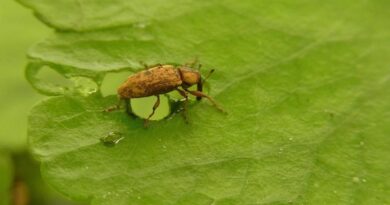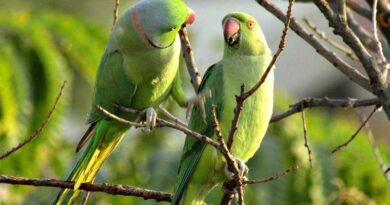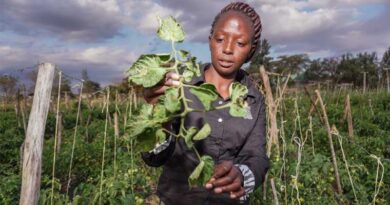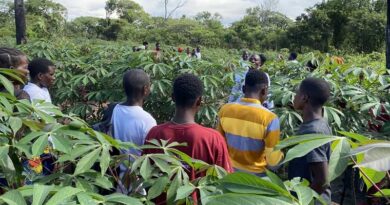Review article traces the origins and tracks movement of invasive rubber vines in over 80 countries and territories
24 November 2023, Brazil: A CABI-led review published in the journal NeoBiota has traced the origins and tracked the movements of invasive rubber vines (Cryptostegia spp., Apocynaceae) as well as summarized their current weed status in more than 80 countries and territories around the world.
The study, which has been compiled jointly with collaborators from the Universidade Estadual de Feira de Santana and the Universidade Federal de Viçosa in Brazil, involved an exhaustive search of published and unpublished sources.
Cryptostegia grandiflora and C. madagascariensis (Apocynaceae) are the only two species of this Madagascan plant genus. Both have been transported around the world as ornamentals due to their attractive flowers and as potential sources of rubber – hence, the common name rubber vine – because of their copious latex, which also contains toxic cardiac glycosides.
Actual or potential threat to native ecosystems
However, because of their vigorous growth and ability to climb over and smother vegetation, both species have become invasive, posing an actual or potential threat to native ecosystems in many tropical and sub-tropical countries, as well as to human and animal health.
Classical biological control (CBC), or the introduction of co-evolved natural enemies from the native range of an invasive alien species to control it in its exotic range, has successfully been used to tackle C. grandiflora in northern Queensland, Australia, where the weed covered over 40,000 km2, with an estimated cost saving of over AUS$300 million to agriculture and saving native Eucalyptus forests from potential extinction.
This strategy is currently being evaluated for its suitability to manage C. madagascariensis in north-eastern Brazil using the same Madagascan rust fungus, Maravalia crytostegiae, that was successful in Australia.
The review paper highlights studies which show that C. madagascariensis is having a significant negative impact on the unique semi-arid Caatinga ecosystem in north-east Brazil. It is affecting the regeneration and ecological succession of native vegetation as well as altering the composition of arbuscular mycorrhizal communities.
However, it is the socio-economic impact on the endemic carnaúba or wax palm (Copernica prunifera) that is the main cause of concern in the region. As well as being an emblematic and keystone species in the States of Ceará, Piauí and Rio Grande do Norte, the palm is also an important source of income and rural employment. In 2019, for example, export of the high-quality wax obtained from the palm leaves was valued at over US$ 40 million to the Brazilian economy.
Prospects for first exotic weed biocontrol agent introduced into Brazil
For CBC to be successful, it is critical to understand the taxonomy of the invader as well as the origin(s) of its weedy biotype(s) to select the best-matched co-evolved natural enemies.
Dr Marion Seier, CABI’s Senior Plant Pathologist and Team Leader – Invasive Species, stated that surveys for fungal pathogens in the native Madagascan range of C. madagascariensis, and subsequent screening in the UK under quarantine greenhouse conditions, identified a strain or pathotype of M. cryptostegiae highly virulent to the only known invasive biotype of C. madagascariensis in Brazil.
Host-specificity testing of the selected pathotype against 48 non-target plants representative of native Brazilian apocynaceous genera and species, as well as locally important species from other plant genera, showed it to be specific to the genus Cryptostegia.
In parallel, studies conducted at three field sites in the Brazilian State of Ceará by scientists from the Universidade Federal do Ceará collated data on C. madagascariensis populations and plant performance to establish a baseline of the invasion.
In the review the scientists highlight that, despite the attraction as an ornamental and perceived usefulness as a source of rubber, caution should be exercised concerning the potential of rubber vine species to become invasive wherever they have been introduced. This is given also because of the threat posed to human health – as well as to livestock and herbivores in general – because of toxic glycosides in the latex.
Dr Seier said, “Their cultivation as ornamentals in public and private gardens must be discouraged and their commercialisation should be forbidden by law. At present, even in places severely impacted by rubber vines, such as in north-east Brazil, they are still being marketed as desirable ornamentals. This is likely to be contributing directly to the expansion of their distribution with all the resulting negative impacts on ecosystem functioning and health.”
Research conducted by CABI into the potential of the rust fungus M. cryptostegiae as a CBC agent formed part of a five-year collaborative project to try and manage Madagascar rubber vine in north-east Brazil.
A socio-economic survey undertaken with landowners and workers involved in the carnaúba wax industry, showed that the economic impacts of C. madagascariensis – as well as its threat to the environment and human welfare – are well understood.
Dr Seier has pointed out that “if the selected strain of M. cryptostegiae were to be approved for release, the rust would be the first exotic weed biocontrol agent introduced into Brazil and its impact on invasive rubber-vine populations will be monitored against the established baseline.”
Also Read: Global Fisheries Conference 2023 to be organized in India on 21-22 November at Ahmedabad
(For Latest Agriculture News & Updates, follow Krishak Jagat on Google News)















